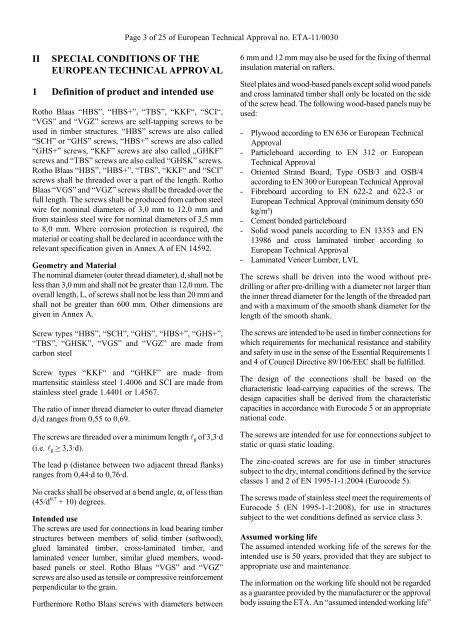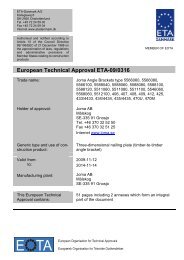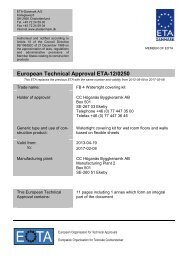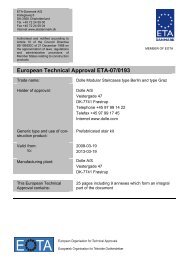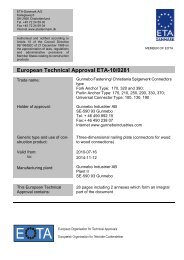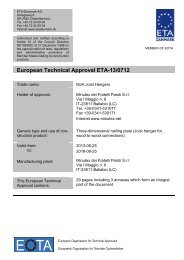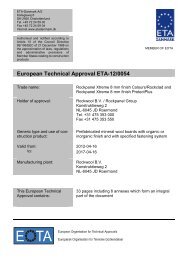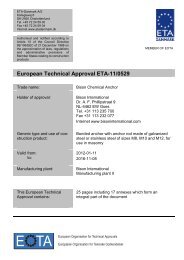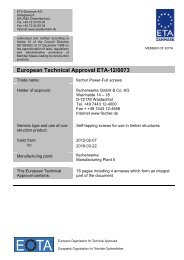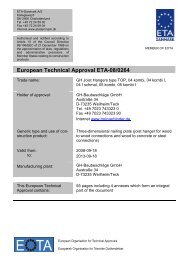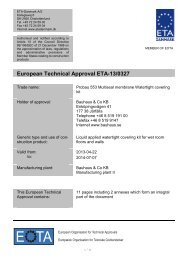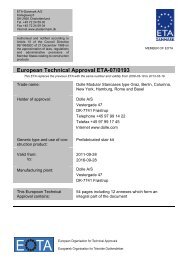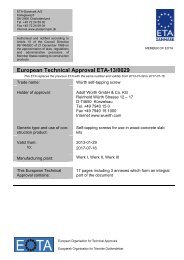ETA110030 RB screws - ETA-Danmark
ETA110030 RB screws - ETA-Danmark
ETA110030 RB screws - ETA-Danmark
You also want an ePaper? Increase the reach of your titles
YUMPU automatically turns print PDFs into web optimized ePapers that Google loves.
Page 3 of 25 of European Technical Approval no. <strong>ETA</strong>-11/0030<br />
II SPECIAL CONDITIONS OF THE<br />
EUROPEAN TECHNICAL APPROVAL<br />
1 Definition of product and intended use<br />
Rotho Blaas “HBS”, “HBS+”, “TBS”, “KKF“, “SCI“,<br />
“VGS” and “VGZ” <strong>screws</strong> are self-tapping <strong>screws</strong> to be<br />
used in timber structures. “HBS” <strong>screws</strong> are also called<br />
“SCH” or “GHS” <strong>screws</strong>, “HBS+” <strong>screws</strong> are also called<br />
“GHS+” <strong>screws</strong>, “KKF” <strong>screws</strong> are also called „GHKF”<br />
<strong>screws</strong> and “TBS” <strong>screws</strong> are also called “GHSK” <strong>screws</strong>.<br />
Rotho Blaas “HBS”, “HBS+”, “TBS”, “KKF“ and “SCI”<br />
<strong>screws</strong> shall be threaded over a part of the length. Rotho<br />
Blaas “VGS” and “VGZ” <strong>screws</strong> shall be threaded over the<br />
full length. The <strong>screws</strong> shall be produced from carbon steel<br />
wire for nominal diameters of 3,0 mm to 12,0 mm and<br />
from stainless steel wire for nominal diameters of 3,5 mm<br />
to 8,0 mm. Where corrosion protection is required, the<br />
material or coating shall be declared in accordance with the<br />
relevant specification given in Annex A of EN 14592.<br />
Geometry and Material<br />
The nominal diameter (outer thread diameter), d, shall not be<br />
less than 3,0 mm and shall not be greater than 12,0 mm. The<br />
overall length, L, of <strong>screws</strong> shall not be less than 20 mm and<br />
shall not be greater than 600 mm. Other dimensions are<br />
given in Annex A.<br />
Screw types “HBS”, “SCH”, “GHS”, “HBS+”, “GHS+”,<br />
“TBS”, “GHSK”, “VGS” and “VGZ” are made from<br />
carbon steel<br />
Screw types “KKF“ and “GHKF” are made from<br />
martensitic stainless steel 1.4006 and SCI are made from<br />
stainless steel grade 1.4401 or 1.4567.<br />
The ratio of inner thread diameter to outer thread diameter<br />
di/d ranges from 0,55 to 0,69.<br />
The <strong>screws</strong> are threaded over a minimum length lg of 3,3·d<br />
(i.e. lg > 3,3·d).<br />
The lead p (distance between two adjacent thread flanks)<br />
ranges from 0,44·d to 0,76·d.<br />
No cracks shall be observed at a bend angle, α, of less than<br />
(45/d 0,7 + 10) degrees.<br />
Intended use<br />
The <strong>screws</strong> are used for connections in load bearing timber<br />
structures between members of solid timber (softwood),<br />
glued laminated timber, cross-laminated timber, and<br />
laminated veneer lumber, similar glued members, woodbased<br />
panels or steel. Rotho Blaas “VGS” and “VGZ”<br />
<strong>screws</strong> are also used as tensile or compressive reinforcement<br />
perpendicular to the grain.<br />
Furthermore Rotho Blaas <strong>screws</strong> with diameters between<br />
6 mm and 12 mm may also be used for the fixing of thermal<br />
insulation material on rafters.<br />
Steel plates and wood-based panels except solid wood panels<br />
and cross laminated timber shall only be located on the side<br />
of the screw head. The following wood-based panels may be<br />
used:<br />
- Plywood according to EN 636 or European Technical<br />
Approval<br />
- Particleboard according to EN 312 or European<br />
Technical Approval<br />
- Oriented Strand Board, Type OSB/3 and OSB/4<br />
according to EN 300 or European Technical Approval<br />
- Fibreboard according to EN 622-2 and 622-3 or<br />
European Technical Approval (minimum density 650<br />
kg/m³)<br />
- Cement bonded particleboard<br />
- Solid wood panels according to EN 13353 and EN<br />
13986 and cross laminated timber according to<br />
European Technical Approval<br />
- Laminated Veneer Lumber, LVL<br />
The <strong>screws</strong> shall be driven into the wood without predrilling<br />
or after pre-drilling with a diameter not larger than<br />
the inner thread diameter for the length of the threaded part<br />
and with a maximum of the smooth shank diameter for the<br />
length of the smooth shank.<br />
The <strong>screws</strong> are intended to be used in timber connections for<br />
which requirements for mechanical resistance and stability<br />
and safety in use in the sense of the Essential Requirements 1<br />
and 4 of Council Directive 89/106/EEC shall be fulfilled.<br />
The design of the connections shall be based on the<br />
characteristic load-carrying capacities of the <strong>screws</strong>. The<br />
design capacities shall be derived from the characteristic<br />
capacities in accordance with Eurocode 5 or an appropriate<br />
national code.<br />
The <strong>screws</strong> are intended for use for connections subject to<br />
static or quasi static loading.<br />
The zinc-coated <strong>screws</strong> are for use in timber structures<br />
subject to the dry, internal conditions defined by the service<br />
classes 1 and 2 of EN 1995-1-1:2004 (Eurocode 5).<br />
The <strong>screws</strong> made of stainless steel meet the requirements of<br />
Eurocode 5 (EN 1995-1-1:2008), for use in structures<br />
subject to the wet conditions defined as service class 3.<br />
Assumed working life<br />
The assumed intended working life of the <strong>screws</strong> for the<br />
intended use is 50 years, provided that they are subject to<br />
appropriate use and maintenance.<br />
The information on the working life should not be regarded<br />
as a guarantee provided by the manufacturer or the approval<br />
body issuing the <strong>ETA</strong>. An “assumed intended working life”


